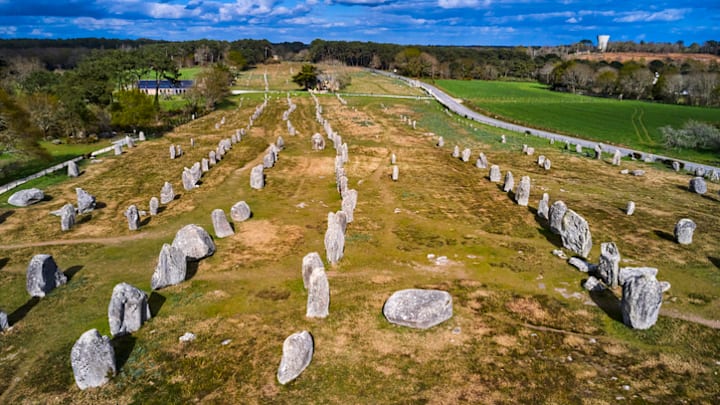by Jordi Lippe
Stonehenge isn’t the only prehistoric monument worth talking about. Assemblies of massive stones as well as monoliths, both natural and human-made, can be found in many countries and take the shape of circles, shelters, lines, or structures. Here are seven worth investigating.
- Puma Punku // Bolivia
- Lake Michigan “Stonehenge” // United States
- Yonaguni Pyramid // Japan
- Moai // Rapa Nui
- Nazca Lines // Peru
- Baalbek Stones // Lebanon
- Carnac Stones // France
Puma Punku // Bolivia

You can visit this massive megalithic complex dating from 500 to 950 CE and marvel at its construction, just like the Spanish conquistadores did when they encountered it in 1549. Its perfectly cut lines, artistic detail, and sheer size are impressive; the Inca once considered it to be part of the site where the world was created. Located in the huge Tiwanaku archaeological complex near Tiwanaku, Bolivia, Puma Punku (“Gate of the Puma”) is built with massive diorite stones weighing up to 450 tons and situated on top of a 13,000-foot plateau.
Lake Michigan “Stonehenge” // United States

Who would have thought Lake Michigan would be home to a prehistoric site? Once believed to be just an underwater shipwreck in the great lake, this mile-long line of medium-sized stones lies 40 feet below the surface and is estimated to be 9000 years old, according to archaeologist Mark Holley. One of the stones may have a carving of a mastodon, an animals that coexisted with humans during the last Ice Age. Holley has suggested that the stones may have been used by Native peoples as a “prehistoric drive line” for herding caribou.
Yonaguni Pyramid // Japan

With its staircases and terraces, this underwater rock formation was discovered in 1985, and debate still rages over its origins. Most geologists consider it a natural sandstone formation, but others remain unconvinced and suggest it’s a remnant of an ancient culture that once inhabited the Japanese islands. You can explore this lost world by strapping on some scuba gear and heading to the southernmost point of the island. Watch out for the area’s hammerhead shark population.
You Might Also Like:
- There Are 72,000 Tons of Diamonds Hiding Throughout This Town in Germany
- 16 Explosive Facts About Volcanoes
- 8 of the World’s Most Spectacular Caves
Moai // Rapa Nui

If the stunning beaches and crystal clear waters aren’t enough to make you want to head to Rapa Nui (a.k.a. Easter Island), then the one-of-a-kind, anthropomorphic moai, dating back to around 1000 CE, certainly will. Built by the Rapa Nui people, these carved bodies (some of which are buried so only the heads are above ground) represent ancestors with the power to watch over and protect living people. Most are located in the main quarry, called Rano Raraku, but some stand closer to the shoreline. All are accessible by car or bike after the 5.5-hour flight from Santiago, Chile.
Nazca Lines // Peru

These Peruvian geoglyphs don’t look so impressive from up close. But head up to a nearby foothill (or take a sightseeing flight) in the Nazca Valley, and you’ll see close to 900 etchings formed in shapes including a monkey, a spider, a hummingbird, a 1000-foot long pelican, lines, circles, and more. There’s one straight line that stretches an impressive nine miles across. The images were created by brushing away the red rocks to reveal grey and white ones underneath. According to archaeologists, some of the configurations may be from as early as 200 BCE.
Baalbek Stones // Lebanon

Visitors can marvel at the three monster stones that were intended to be the podium of a statue of Jupiter Baal at the Roman city of Heliopolis (modern-day Baalbek, Lebanon), which are among the largest stones ever hewn by humans. Each of the three, nicknamed the Stone of the Pregnant Woman, the Stone of the South, and the Forgotten Stone—weighs about 900 tons [PDF]. The stones potentially predate the time of Alexander the Great.
Carnac Stones // France

This collection of standing stones in different formations is exceptional in size and preservation. At roughly 7000 years old and containing about 3000 stones of local granite, Carnac is the largest such assembly in the world. Rock fans will find numerous formations here:
- Menhirs: large, upright single blocks
- Dolmens: stone tombs resembling tables, made from vertical and horizontal blocks
- Alignments: rows of multiple menhirs
- Tumuli: mounds of earth built over dolmens (also called barrows)
As with many prehistoric monuments, Carnac’s purpose is unknown, but archaeologists have proposed that it could have served as a place for worship, an astronomical calendar, or a sacred funerary site.
Discover More Fascinating Geology Stories:
A version of this story was published in 2015; it has been updated for 2025.
